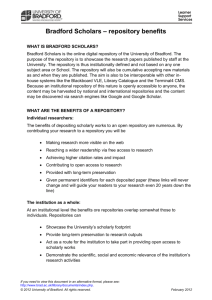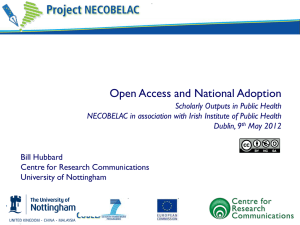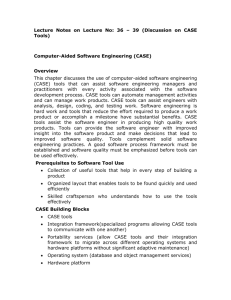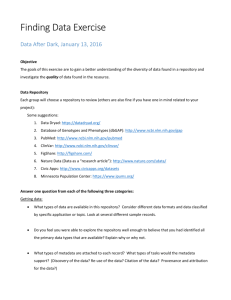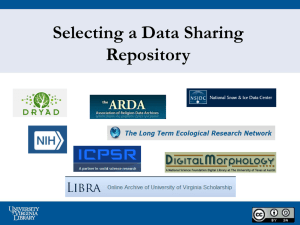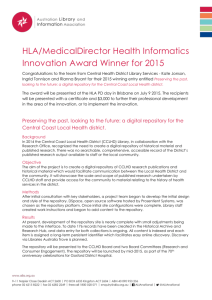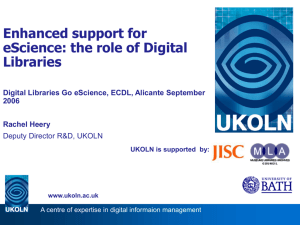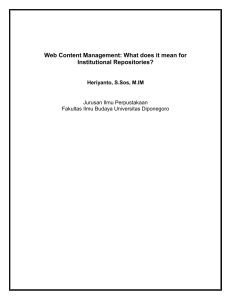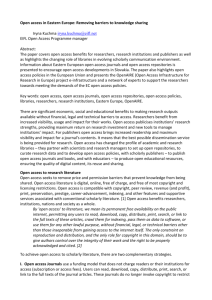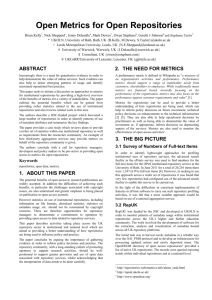guidelines for developing and maintaining institutional repositories
advertisement
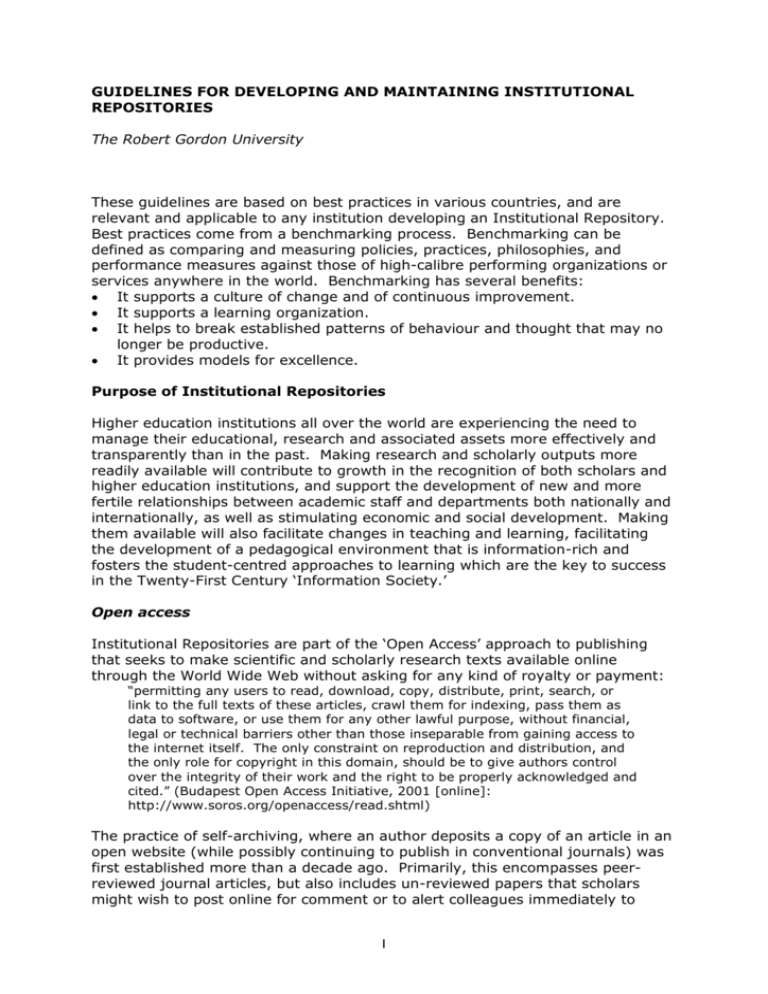
GUIDELINES FOR DEVELOPING AND MAINTAINING INSTITUTIONAL REPOSITORIES The Robert Gordon University These guidelines are based on best practices in various countries, and are relevant and applicable to any institution developing an Institutional Repository. Best practices come from a benchmarking process. Benchmarking can be defined as comparing and measuring policies, practices, philosophies, and performance measures against those of high-calibre performing organizations or services anywhere in the world. Benchmarking has several benefits: It supports a culture of change and of continuous improvement. It supports a learning organization. It helps to break established patterns of behaviour and thought that may no longer be productive. It provides models for excellence. Purpose of Institutional Repositories Higher education institutions all over the world are experiencing the need to manage their educational, research and associated assets more effectively and transparently than in the past. Making research and scholarly outputs more readily available will contribute to growth in the recognition of both scholars and higher education institutions, and support the development of new and more fertile relationships between academic staff and departments both nationally and internationally, as well as stimulating economic and social development. Making them available will also facilitate changes in teaching and learning, facilitating the development of a pedagogical environment that is information-rich and fosters the student-centred approaches to learning which are the key to success in the Twenty-First Century ‘Information Society.’ Open access Institutional Repositories are part of the ‘Open Access’ approach to publishing that seeks to make scientific and scholarly research texts available online through the World Wide Web without asking for any kind of royalty or payment: “permitting any users to read, download, copy, distribute, print, search, or link to the full texts of these articles, crawl them for indexing, pass them as data to software, or use them for any other lawful purpose, without financial, legal or technical barriers other than those inseparable from gaining access to the internet itself. The only constraint on reproduction and distribution, and the only role for copyright in this domain, should be to give authors control over the integrity of their work and the right to be properly acknowledged and cited.” (Budapest Open Access Initiative, 2001 [online]: http://www.soros.org/openaccess/read.shtml) The practice of self-archiving, where an author deposits a copy of an article in an open website (while possibly continuing to publish in conventional journals) was first established more than a decade ago. Primarily, this encompasses peerreviewed journal articles, but also includes un-reviewed papers that scholars might wish to post online for comment or to alert colleagues immediately to 1 important research findings. Increasingly, Institutional Repositories are being developed to make possible more structured and comprehensive access to these scholarly publications. Open Access is particularly important for the less industrialised countries, and especially those where English is not the major language. Printed journals published in the less industrialised countries tend to suffer from irregular publication, poor distribution, and limited national and international visibility. The need for scientists and other scholars to publish their findings in journals with a high impact (e.g. as recognised by ISI’s Citation Indexes) in order to gain recognition may be constrained by the fact that very few non-English language journals are indexed by ISI. This leads to a preference for publication in international journals, which may not be accessible - for financial or linguistic reasons – to the local academic and research communities. Research papers made available through Repositories may have a higher national and global impact than publication in a conventional printed indigenous journal. Institutional Repositories In the simplest terms, an Institutional Repository is an electronic archive of the scientific and scholarly outputs of an institution, which have been stored in a searchable digital format and which are able to be retrieved for later use internally, nationally, and worldwide. A Repository supports mechanisms to import, identify, store, preserve, retrieve, and export an institution’s digital assets, usually in the form of web pages. It is a type of content management system that holds the core intellectual assets of a university or college, and enables them to be used in a flexible way to support a variety of business processes. These intellectual assets include research and scholarly outputs, such as journal articles and theses, but may also include teaching and learning materials, presentations, research datasets, audiovisual records, and e-learning objects. Institutional Repositories enable the free sharing of information, encouraging collaboration and the widespread communication of educational and research activity. Much of the interest in Institutional Repositories to date has concentrated on research outputs, because it is becoming important for institutions to capture the results of research funded by public or charitable organisations which increasingly require open publication as part of the conditions attached to their research grants. However, they have also been recognised as a valuable medium for promoting awareness of the research outputs of institutions in countries where the indigenous publishing industry is not sufficiently well established to ensure that its outputs reach an international audience. Moreover, where content is managed in a way that makes access and re-use easy, it also has a great potential to impact positively on the quality of the learning experience. Information strategy For any higher education institution, an Institutional Repository should be an important central element of an information strategy that encompasses and integrates the development of its libraries, Virtual Learning Environment, publishing programme, records and archives service, management information 2 system, and communication network. The creation and effective organisation of these systems and services requires significant high level planning and support, as well as a good level of technical and managerial competence, supported by appropriate staff training programmes. There are tangible benefits for those institutions that can demonstrate effective information strategies and develop and exploit systems for this purpose. Repositories help institutions to develop coherent and coordinated approaches to the capture and exploitation of their intellectual assets, using them for different purposes, such as teaching a course via a Virtual Learning Environment (VLE), or underpinning a website, as well as collating a university’s research outputs across a particular subject area or period of time. Putting content into a digital Repository enables institutions and their staff to manage it, and thus derive maximum value from it. A managed approach to these assets enhances opportunities for the efficient promotion and use of existing research outputs, increases opportunities for improved learning experiences, and encourages collaboration within and between different disciplines and groups nationally and internationally. Institutional Repositories can also stimulate a culture change in teaching and learning, as teachers could review how they use the stored material to deliver their courses and focus on how to improve the students’ learning experience. In designing Institutional Repositories, a number of policy, technical, and managerial issues need to be recognised and addressed in depth, including: Choice of software, including consideration of Open Source solutions, and compliance with international protocols; Content acquisition and quality assurance; Intellectual Property Rights; Creation of metadata, and other approaches to raising the visibility of the content; Managing a sustainable archive. The institution’s library offers a unique blend of knowledge and skills in collecting, organising, preserving and sharing information and in providing a cross-institutional service. Whilst not the only staff of the institution that should be involved in the development of a Repository, the library’s staff should be seen to be playing a leading role, in collaboration with the academic departments and the Information Technology service. 3 Marketing and promotion User awareness raising and motivation requires careful attention if new electronic systems are to take off and achieve their potential among the user communities. Getting content, persuading the academic community to contribute material, is often the biggest problem faced by the developers of an Institutional Repository. Significant and continuing advocacy is required to follow up any statement of institutional policy. Advocacy In order to encourage staff to place their papers in the Repository, a mandate to do so, issued by the University authorities is only a starting point. It is equally important that staff should be made aware of the advantages of depositing material in the Repository, and that could be reinforced by regularly making the results of the Repository visible, for example through an analysis of the citation of papers by the institution’s staff. Institutions should also seek to make the process of depositing papers as simple and as compatible with existing practices as possible. Metadata creation The creation of metadata, the records that act as proxies for the content of the Institutional Repository, allows those holdings to be discovered. Different metadata schemas may be appropriate for the different types of content in the Repository, and rigour in their application is essential, but it is equally important that the search engines or metadata harvesters should be made aware of the existence of the Repository. Quality assurance and enhancement In conventional publishing the journal is often seen as a brand. In marketing, a brand represents the sum of public perceptions of the quality of goods or services. For the Institutional Repository, the creation of a brand identity may be equally important. A simple initial approach may be to ensure that, wherever possible, each item bears the institutional logo. The adoption of a house style for the layout and typography of documents in the Repository may be another approach. However, a particular challenge will be to establish a general perception of the quality of the contents of the Repository. In conventional journal publishing, this is achieved through the selection of an editor with a recognised national or international status, through the standing of the members of the editorial advisory board, and especially through the peer review mechanism. However, selection of contents may conflict with an institutional strategy that requires all staff outputs to be included, and this issue should be resolved before the establishment of the Repository. e-Marketing e-Marketing is increasingly becoming the primary means of awareness building and communication within the education market place. Complex international and local markets have become increasing fragmented and flooded with undifferentiated courses. e-Marketing facilitates cost-effective market entry, 4 extended market reach, market segmentation and visibility of performance, localisation of marketing campaigns and allows appropriate audiences to be targeted and market fragmentation to be addressed. Due to constraints of geography, market awareness, competitive market environment, national and international institutional reputation, and institutional expertise in e-marketing, most institutions need to follow criterion-based emarketing strategies. The logic is to pursue market driven opportunities that are based on key processes and unique but relatively simple criteria. There are five cost-effective, synergistic criterion-based strategies which can be applied in full or in a systematic manner: customer-effective web development, search-engine optimisation (SEO), search-engine registration, pay-per-click (PPC) advertising, and email marketing. The inter-relationship of these strategies is outlined in figure 1 below. Over 90% of global search volume is generated from Google, Yahoo and Inktomi. Google is an online reputation system (ORS) and has 35% market share. The exact mechanism of how these ORSs operate is a closely guarded industry secret, but we can glean that a site’s reputation is built on a number of factors including: Reputation of domain name; Volume of links into your site (including the reputation of their domain names); Keyword alignment from domain name through to page content; Relevancy of keywords; Volume of traffic to your site; Age of site; Domain name country code; Rate of increase in page links to your site; 5 Figure 1: e-Marketing Process Common Business Objectives Every higher education institution should aim to drive traffic to its website, and To make every ‘product’s’ (e.g. course, research group) web page a ‘landing’ page for search engines 6 To make hyperlinks with reputable directories, professional bodies and industry web sites To appear in the top 20 search list for top 5 search engines for targeted keywords The Solution To increase the reputation and attraction power of a website, it is necessary to formulate and implement a number of simple rules and established actions. Search Engine Optimisation and search registration strategies are focused on producing organic traffic to your website and increasing site reputation. Increasing site reputation can take a considerable amount time. Search Engine Optimisation actions include: Identifying keywords and determine keyword effectiveness and search volume; Tailoring the meta detail of products around a minimum of 5 keywords. Registration actions include: Each course having a comprehensive listing in the major directories; All relevant directory sites being targeted; Comprehensive listings in general and local directories being pursued; Specialist sites being identified and a registration sought for each subject. Software such as IBP and Arelis could be used to assist with the process. This will make most of this process semi-automatic. Pay Per Click advertising allows you to attract immediate high volume global traffic. eMail marketing allows you to engage with the potential market with a tailored reinforcing message. With email marketing you can either generate your own lists or buy this service from a media company. For pay-per-click (PPC) the following approaches could be used: Target PPC programmes that are syndicated to the major search engines; Seek ‘First mover advantage’ with evolving PPC programmes; Develop low cost bid management strategies; Calculate Return On Investment for each keyword and amend bidding strategies accordingly; Adopt a click fraud policy. PPC actions include: Identify high volume keywords; Develop campaigns to obtain a top 10 listing per top 10 searched keywords in Google, Yahoo Search Marketing, and Miva; Tailor campaigns for each geographic region, including language specific keyword development; Make adverts clear and unambiguous; Align advertising on the institution’s homepage with prominent PPC campaigns. 7
